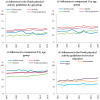Adhering to the 2017 Dutch Physical Activity Guidelines: A Trend over Time 2001-2018
- PMID: 31973048
- PMCID: PMC7037925
- DOI: 10.3390/ijerph17030681
Adhering to the 2017 Dutch Physical Activity Guidelines: A Trend over Time 2001-2018
Abstract
Recently, new physical activity (PA) guidelines were adopted in the Netherlands consisting of two components: (1) addressing duration of moderate and vigorous PA, (2) bone and muscle strengthening activities. The aim of this study is to retrospectively assess the long-term trend in fulfilling the criteria of the new PA guidelines and to gain insight into which activities contribute to changes over time. Data were available for 2001-2018 of a nationally representative sample of approximately 7000 Dutch citizens aged 12 years and over using the Short Questionnaire to Assess Health-enhancing physical activity (SQUASH). Multiple logistic regression analysis was performed by age, sex, and level of education. Overall, a positive trend was found from 39.9% adherence in 2001 to 46.0% in 2018. Adherence levels among adolescents decreased and increased among adults and seniors. Intermediate and higher educated groups showed positive trends over time whereas a stable trend was observed among lower educated. Activities contributing most to changes over time were sports, leisure time walking, and strenuous occupational activities. In the period 2001-2018, though an increasing trend was found, less than half of the population was sufficiently active. Special effort is necessary to reach adolescents, seniors, and lower educated groups in PA promotion programs.
Keywords: bone and muscle strengthening activities; cross-sectional; exercise; guideline; health; physical activity; trend.
Conflict of interest statement
The authors declare that they have no actual or potential competing financial interests.
Figures



References
-
- Forouzanfar M.H., Afshin A., Alexander L.T., Anderson H.R., Bhutta Z.A., Biryukov S., Brauer M., Burnett R., Cercy K., Charlson F.J., et al. Global, regional, and national comparative risk assessment of 79 behavioural, environmental and occupational, and metabolic risks or clusters of risks, 1990–2015: A systematic analysis for the Global Burden of Disease Study 2015. Lancet. 2016;388:1659–1724. doi: 10.1016/S0140-6736(16)31679-8. - DOI - PMC - PubMed
-
- Lee I.-M., Shiroma E.J., Lobelo F., Puska P., Blair S.N., Katzmarzyk P.T. Lancet Physical Activity Series Working Group. Effect of physical inactivity on major non-communicable diseases worldwide: An analysis of burden of disease and life expectancy. Lancet. 2012;380:219–229. doi: 10.1016/S0140-6736(12)61031-9. - DOI - PMC - PubMed
-
- Ding D., Lawson K.D., Kolbe-Alexander T.L., Finkelstein E.A., Katzmarzyk P.T., Van Mechelen W., Pratt M. Lancet Physical Activity Series 2 Executive Committee The economic burden of physical inactivity: A global analysis of major non-communicable diseases. Lancet. 2016;388:1311–1324. doi: 10.1016/S0140-6736(16)30383-X. - DOI - PubMed
-
- World Health Organization . Global Action Plan for the Prevention and Control of Noncommunicable Diseases 2013–2020. World Health Organization; Geneva, Switzerland: 2013.
Publication types
MeSH terms
LinkOut - more resources
Full Text Sources
Medical

